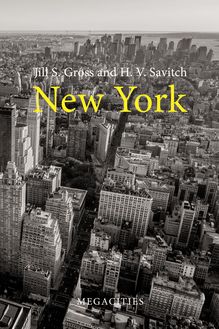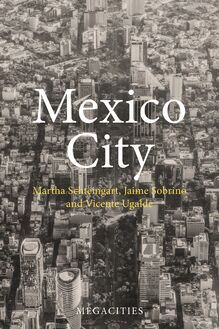-
 Univers
Univers
-
 Ebooks
Ebooks
-
 Livres audio
Livres audio
-
 Presse
Presse
-
 Podcasts
Podcasts
-
 BD
BD
-
 Documents
Documents
-
- Cours
- Révisions
- Ressources pédagogiques
- Sciences de l’éducation
- Manuels scolaires
- Langues
- Travaux de classe
- Annales de BEP
- Etudes supérieures
- Maternelle et primaire
- Fiches de lecture
- Orientation scolaire
- Méthodologie
- Corrigés de devoir
- Annales d’examens et concours
- Annales du bac
- Annales du brevet
- Rapports de stage
La lecture à portée de main
Vous pourrez modifier la taille du texte de cet ouvrage
Découvre YouScribe en t'inscrivant gratuitement
Je m'inscrisDécouvre YouScribe en t'inscrivant gratuitement
Je m'inscrisEn savoir plus
Vous pourrez modifier la taille du texte de cet ouvrage
En savoir plus

Description
New York became the world's first megacity in the 1930s. Since then it has remained the largest city in North America but, globally, it has been surpassed in size by the younger cities of Asia. Nevetheless its metropolitan area is home to 20 million people and it continues to be America's premier city.
Jill Gross and Hank Savitch examine the New York metropolis through the lens of a series of twenty-first century pressures related to demography, economic growth, urban development, governance, immigration, leadership and globalization. How New York's institutions and policies have either risen to meet these challenges, stagnated in the face of them, or simply failed to resolve them is the focus of the book. In particular, the authors examine the muncipality of New York City, as the heart of the megacity, and how it navigates the increasingly complex battles with higher levels of government over rights to the city and resource needs.
The book examines the shifting tides of corporate centred development, particularly the vibrant financial sector, and how it has leveraged its powerful geopolitical position in the global economy to continue to grow. The question of governance is explored along with the growing reliance on public–private partnerships to manage megacity problems. Mayoral control and leadership is shown to have been fundamental to meeting the needs of the residential population – issues such as crime, schools and housing – along with the demands of business. With over 3 million immigrants, New York is the most diverse city in North America, but it is also among the most segregated and the authors investigate the positive and negative outcomes that such diversity brings.
As a comprehensive analysis of the political, economic and social dynamics that have made New York a megacity today, the book will be of interest to a broad readership in political science, public administration, public policy, sociology, geography, political economy, urban planning and regional studies.
1. Introduction: New York as a megacity
2. Crises, breakdowns and New York’s endurance
3. Building a global megacity: corporate-centered urban development and leaderships
4. Expanded governance in the megacity
5. Neighborhoods, diversification and gentrification in the megacity
6. Globalization in the megacity
7. Conclusions
Sujets
Informations
| Publié par | Agenda Publishing |
| Date de parution | 23 mars 2023 |
| Nombre de lectures | 5 |
| EAN13 | 9781788215428 |
| Langue | English |
| Poids de l'ouvrage | 1 Mo |
Informations légales : prix de location à la page 0,1500€. Cette information est donnée uniquement à titre indicatif conformément à la législation en vigueur.
Extrait
New York
Megacities
Series Editor: H. V. Savitch
As drivers of economic growth, demographic change and consumption hyper-conurbations offer unique opportunities to their hinterlands and national economies, as well as huge challenges of governance, planning and provisioning. Each book in this series examines the political and economic development of a specific megacity and explores how and why they have evolved and how policy decisions, couched in geopolitics, have shaped their outcomes. The series covers both paradigmatic mature megacities of the developed world, as well as the fast-growing emerging megacities of South and East Asia, and Latin America.
Published
London
Mike Raco and Frances Brill
Mexico City
Martha Schteingart, Jaime Sobrino and Vicente Ugalde
New York
Jill S. Gross and H. V. Savitch
Paris
Christian Lefèvre
New York
Jill S. Gross and H. V. Savitch
Dedicated to our students, past, present and future.
© Jill S. Gross and H. V. Savitch 2023
This book is copyright under the Berne Convention.
No reproduction without permission.
All rights reserved.
First published in 2023 by Agenda Publishing
Agenda Publishing Limited
The Core
Bath Lane
Newcastle Helix
Newcastle upon Tyne
NE4 5TF
www.agendapub.com
ISBN 978-1-78821-203-8 (hardcover)
ISBN 978-1-78821-204-5 (paperback)
British Library Cataloguing-in-Publication Data
A catalogue record for this book is available from the British Library
Typeset by Newgen Publishing UK
Printed and bound in the UK by CPI Group (UK) Ltd, Croydon, CR0 4YY
Contents
Preface and acknowledgements
1 Introduction: New York as a megacity
2 Crises, breakdowns and New York’s endurance
3 Building a global megacity: corporate-centred urban development and leadership
4 Expanded governance in the megacity
5 Neighbourhoods, diversification and gentrification in the megacity
6 Globalization in the megacity
7 Conclusions
References
Index
Preface and acknowledgements
Alison Howson was first to broach the idea of doing a series on the world’s megacities. We took to it immediately and with enthusiasm. Both of us had been familiar with the world’s great cities from both scholarly and personal experience. The promise of doing original work on New York sparked our imaginations. It is, after all, an ideal example of a megacity. Its five counties (boroughs) cover a land mass of more than 200 square miles, and its population of more than eight million people and its high densities make for one of the largest and most packed cities on the planet. In reflecting further, we noted that New York was filled with seeming contradictions. Travelling each day along a vast web of highways, airports and rail can be either surprisingly easy or painfully slow. The New York megacity is immensely rich and deeply impoverished. Its culture and people are steeped in kindness, yet renowned to be rude. It is not the contradictions themselves that pose the issue, but New York’s size and diversity that provide the space and opportunity for an immensity of contrasts.
From a strictly formal point of view New York City falls just short of the ten million residents needed to constitute a megacity. We are, however, saved from this criterion by the reality of a Greater New York, whose population reaches 15 million. The day-to-day routines of the larger metropolis cross political boundaries with hardly a thought about who is doing business where. Commuters freely travel throughout the region for commerce, to visit friends or to see the sights. For this reason we have set our focus on a reachable New York metropolis that stretches across 13 counties. 1 This is the New York in which most people work, play and fight over.
Why might it be important to write about this megacity? Firstly, context counts and “the city” itself exists in a greater environment of suburbs, other municipalities, special districts and state governance. The policies of surrounding localities have a profound effect on the city, whether they are related to exclusionary zoning or enormous traffic; both of which respectively have driven up housing affordability and hurt quality of life. A major source of New York’s water supply is located about 40 miles beyond its northern boundary. Only a view of the larger New York can capture essential variables and provide context.
Secondly, we might want to know whether size really matters. Once a city reaches gargantuan proportions, the city’s functions reflexively enlarge, its conflicts become supercharged and its policies drift into greater complexity. Thus, we see a profusion of public authorities (public benefit corporations) trying to knit together different parts of the metropolis. We also witness the volatility of the region’s politics and occasional outbursts of collective violence. It takes smart and practical policies to help the megacity manage growth, and we take note of how its many parts interact. We explore how the megacity deals with problems of this sort, either collectively or through its individual parts.
Lastly, the mere existence of the New York megacity gives all cities a glimpse of their future. Many cities around the world grow every day by increments, without knowing where they could wind up. If this is where New York is today, are other big cities likely to follow? Somehow institutions, practices and policies need to accommodate growth. Whether cities do this in the “New York” style by increments or by a grand, comprehensive design is for each metropolis to decide. New York has been especially good at managing some crises – issues that come to mind are its ability to cope with weather disasters and deal with epidemics. Over the years the New York megacity has enlarged its functions and this should stoke the curiosity of other growing regions.
We trust the experience of the New York megacity will put these issues into perspective. This book is a venture in exploring critical questions. It begins with an overview of megacity complexities and introduces a framework used to analyze why tensions and crises arise, how they are coped with and whether the megacity is effective in managing them. We use critical events to demonstrate our propositions, ranging from the megacity’s corporate development to its expanded governance and down to its changing neighbourhoods. We also examine how it functions as a “global city” in a competitive world. Finally, we end with a series of findings about the New York megacity and offer a number of “axioms” about its long-term resilience.
It takes a lifetime to appreciate the complexities of a great city, and even then we scratch at surfaces. We are so very privileged to be able to thank colleagues, friends and family for nurturing that experience. Hank Savitch is greatly indebted to his colleagues at Urban and Public Affairs at the University of Louisville. Ron Vogel, Steve Bourassa, Dave Simpson and David Imbroscio were superb friends and critics. Herman Boschken (San Jose State University) and Ron Vogel (Ryerson University, Canada) were immensely helpful when it came to treating New York in a global context. A raft of former students, many of whom have distinguished themselves, provided a much-valued context. Among these were David Collins, Grigoriy Ardashev, Kevin Dupont, Jeff Osborne, Lin Ye, Anar Valiyev, Ismaila Odogba, Lynn Roche-Phillips, Eric Yankson and Doddy Iskandar.
Jill S. Gross has had a front row seat to the evolving New York megacity story, having had the great fortune to live and work there for most of her life. The politics and development of the megacity have served as inspiration and influence for her research, writing and teaching. She is grateful for the support she has received from her colleagues in the Department of Urban Policy and Planning at Hunter College of the City University of New York, whose combined historic knowledge, cutting-edge research and contemporary hands-on experience in policy and planning for this great city have been invaluable. Her extended academic community in the US and abroad and at the Urban Affairs Association have also proved critical for this project. Her students are a constant source of inspiration, experiential knowledge, and enthusiasm about where this megacity has come from and what the future holds. The direct contributions of research assistant Erica Saunders, and Charles Rudoy for his case study materials on the New Jersey Gateway region, are so appreciated.
Family means everything. Susan Savitch captured Hank’s heart more than 60 years ago and holds it to this day. With patience and love she has encouraged this work. Adam and Jonathan Savitch frequently wondered whether their dad might be writing the same book more than a dozen times. They were assured this was not the case. Jennifer Savitch was always positive and so very generous. Adam Savitch and Steven Salzgeber were always there to help. They were indispensable in producing new illustrations and rescuing old ones. Grandsons Luke and Ethan always cast a presence with their love.
Jill has had the amazing support of her husband Michael Marks, whom she describes as her rock, providing practical, emotional and intellectual support. He has listened to each story, provided some of his own, and most importantly – made sure she ate, slept and occasionally left her computer during the extended writing process. Her mother Diane Merzon, father Jack Gross and siblings Andrew and Ari Gross have served as her cheering section, as has her extended family Hildy, Marty, Scott and Peter Krull, Elizabeth Disney and Debby Gross. Close friends cannot be discounted, and two have been critical to all, Karen Schwartz and Gallya Lahav, who have served as sounding boards to this story, offering sage advice and encouragement throughout. Most importantly, it has been a great honour for Jill to work with one of her academic inspirations, Hank Savitch. Having the opportunity to collaborate with him on this pr
-
 Univers
Univers
-
 Ebooks
Ebooks
-
 Livres audio
Livres audio
-
 Presse
Presse
-
 Podcasts
Podcasts
-
 BD
BD
-
 Documents
Documents
-
Jeunesse
-
Littérature
-
Ressources professionnelles
-
Santé et bien-être
-
Savoirs
-
Education
-
Loisirs et hobbies
-
Art, musique et cinéma
-
Actualité et débat de société
-
Jeunesse
-
Littérature
-
Ressources professionnelles
-
Santé et bien-être
-
Savoirs
-
Education
-
Loisirs et hobbies
-
Art, musique et cinéma
-
Actualité et débat de société
-
Actualités
-
Lifestyle
-
Presse jeunesse
-
Presse professionnelle
-
Pratique
-
Presse sportive
-
Presse internationale
-
Culture & Médias
-
Action et Aventures
-
Science-fiction et Fantasy
-
Société
-
Jeunesse
-
Littérature
-
Ressources professionnelles
-
Santé et bien-être
-
Savoirs
-
Education
-
Loisirs et hobbies
-
Art, musique et cinéma
-
Actualité et débat de société
- Cours
- Révisions
- Ressources pédagogiques
- Sciences de l’éducation
- Manuels scolaires
- Langues
- Travaux de classe
- Annales de BEP
- Etudes supérieures
- Maternelle et primaire
- Fiches de lecture
- Orientation scolaire
- Méthodologie
- Corrigés de devoir
- Annales d’examens et concours
- Annales du bac
- Annales du brevet
- Rapports de stage








